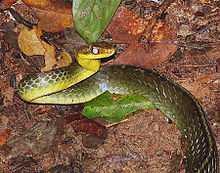Chironius carinatus
| machete savane | |
|---|---|
 | |
| Scientific classification | |
| Kingdom: | Animalia |
| Phylum: | Chordata |
| Subphylum: | Vertebrata |
| Class: | Reptilia |
| Order: | Squamata |
| Suborder: | Serpentes |
| Family: | Colubridae |
| Subfamily: | Colubrinae |
| Genus: | Chironius |
| Species: | C. carinatus |
| Binomial name | |
| Chironius carinatus (Linnaeus, 1758) | |
| Synonyms | |
|
Coluber carinatus Linnaeus, 1758 | |
Chironius carinatus, commonly known as the machete savane, is a very large, but slender colubrid snake. Not only is known to be a nonvenomous snake, but also for its pacific behavior.
Geographic range
It is endemic to the Colombia, northern Brazil to Costa Rica, eastern Venezuela, and Trinidad and Tobago.
Description
Chironius carinatus may grow to 3 m (9.8 feet) in total length. Body color can range from brown to deep yellow or gold, with the tail being generally darker than the body. The belly is often a bright shade of yellow or orange. In most specimens, body scales have lightly colored centers with darker edges. A light colored stripe runs down the length of the body, fading at the tail. The dorsal scales are in 12 rows.[1]
Diet
It feeds on frogs, mice and birds.
References
- ↑ Boulenger, G.A. 1894. Catalogue of the Snakes in the British Museum (Natural History), Volume II. London. pp. 73-75.
Boos, Hans E.A. (2001). The snakes of Trinidad and Tobago. Texas A&M University Press, College Station, TX. ISBN 1-58544-116-3.